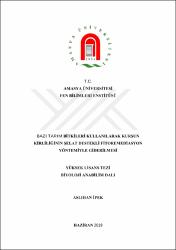| dc.contributor.advisor | Kılıç, Dudu Duygu | |
| dc.contributor.author | İpek, Aslıhan | |
| dc.date.accessioned | 2022-03-09T14:56:12Z | |
| dc.date.available | 2022-03-09T14:56:12Z | |
| dc.date.issued | 2019 | |
| dc.identifier.uri | https://tez.yok.gov.tr/UlusalTezMerkezi/TezGoster?key=jNRDC1RLfVd4_T7x7ZXmmWOf9dn5D_PZz-iWtfrDz7ovTF1qMrjwdwcT_TNbMyo3 | |
| dc.identifier.uri | https://hdl.handle.net/20.500.12450/1870 | |
| dc.description.abstract | Fitoremediasyon, toprağın yer altı ve yer üstü sularının, hatta havadaki kirleticilerin ortadan yok edilmesinde bitkilerin kullanıldığı bir yöntemdir. Bu çalışmada, Brassica napus L.(kanola), Chenopodium quinoa Willd. (kinoa) ve Allium cepa L. (soğan), türleri kullanılarak sentetik olarak kirletilmiş topraktan ve doğal kirlilik içeren arıtma çamurundan Pb elementinin fitoremediasyon yöntemi ile temizlenmesi araştırılmıştır. Ayrıca fitoremediasyon kapasitesini artırmak üzere kompleks yapıcı şelat ve mikrobiyal gübre ilave edilip, bitkilerin element giderim performanslarındaki değişimler gözlenmiştir. Ağır metal gideriminde şelat desteği olarak EDTA, nitro, piridin, 1-10 fenantrolin ve hümik asit kullanılmıştır. Tolerans İndeksi (Tİ) değerleri incelendiğinde şelat ilavesinin bitkilerin gelişimi ve kuru ağırlık miktarlarında değişikliğe neden olduğu tespit edilmiştir. Çalışmada bitkilerin kök, gövde ve yapraklarında ağır metal biriktirme miktarları incelenmiş ve türlerin köklerinde biriktirmenin daha fazla olduğu tespit edilmiştir. Özellikle hümik asit, EDTA ve nitro şelatının kullanıldığı deneme saksılarında ağır metal biriktirme miktarı daha yüksek bulunmuştur. Taşıma Faktörü (TF) değerleri incelendiğinde EDTA, hümik asit, piridin ve 1-10 fenantrolin şelatında A. cepa> C. quinoa> B. napus, nitro şelatında ise C. quinoa> A. cepa> B. napus bulunmuştur. En etkili birikim ise A.cepa ve C. quinoa türlerinde gerçekleşmiştir. Hiperakümülatör olarak bilinen B. napus nitro, piridin ve 1-10 fenantrolin şelatları eklendiği zaman bu özelliğini göstermediği belirlenmiştir. Türlerin Pb elementini köklerde biriktirme ve üst organlara taşımasının şelat ekleme ile arttığı tespit edilmiştir. Buna göre, ağır metal alımını artırmak için hümik asit, EDTA ve nitro kullanılabileceğini göstermektedir. | en_US |
| dc.description.abstract | Phytoremediation is a method which plants are used to eliminate soil, underground, surface waters and even airborne pollutants. In this study, Brassica napus L. Chenopodium quinoa Willd. and Allium cepa L. species are used by the phytomediation method for the removal of the Pb element from the soil that is synthically contaminated and the sludge that is natural contaminated, were investigated. In addition, complex constructor chelate and microbial fertilizer were added to increase phytoremediation capacity and changes in element removal performance of plants were observed. EDTA, nitro, pyridine, 1-10 phenanthroline, and humic acid were used as chelate support in heavy metal removal. When the Tolerance Index (TI) values were examined, it was determined that the addition of chelate caused a change in the growth and dry weight amounts of the plants. In the study, the amount of heavy metal deposition in the root, stem and leaves of the plants were investigated and it was found that accumulation of the species in the roots was more. The amount of heavy metal accumulation was found higher in experimental pots especially used humic acid, EDTA and nitro chelate. When the Transport Factor (TF) values were examined, EDTA, humic acid, pyridine and 1-10 phenantroline chelate were found like A. cepa> C. quinoa> B. napus and also nitro chelate was found like C. quinoa> A. cepa> B. napus. The most effective accumulation was in A.cepa and C. quinoa species. When B. napus nitro, pyridine and 1-10 phenanthroline chelate, which are known as hyperaccumulators, were added, observed that this feature was not shown. It was determined that species Pb element accumulation in the roots and carrying to the upper organs , increased with the chelate addition. Accordingly, it shows that humic acid, EDTA and nitro can be used to increase heavy metal uptake. | en_US |
| dc.language.iso | tur | en_US |
| dc.publisher | Amasya Üniversitesi | en_US |
| dc.rights | info:eu-repo/semantics/openAccess | en_US |
| dc.subject | Biyoloji | en_US |
| dc.subject | Biology | en_US |
| dc.title | Bazı tarım bitkileri kullanılarak kurşun kirliliğinin şelat destekli fitoremediasyon yöntemiyle giderilmesi | en_US |
| dc.title.alternative | Elemination of lead pollution with chelate by using some agricultural plants from the soils by fitting phytoremediation method | en_US |
| dc.type | masterThesis | en_US |
| dc.department | Enstitüler, Fen Bilimleri Enstitüsü, Biyoloji Ana Bilim Dalı | en_US |
| dc.identifier.startpage | 1 | en_US |
| dc.identifier.endpage | 146 | en_US |
| dc.relation.publicationcategory | Tez | en_US |
| dc.identifier.yoktezid | 573729 | en_US |
| dc.institutionauthor | İpek, Aslıhan | |


















